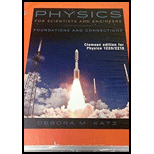
Physics for Scientists and Engineers: Foundations and Connections
15th Edition
ISBN: 9781305289963
Author: Debora M. Katz
Publisher: Cengage Custom Learning
expand_more
expand_more
format_list_bulleted
Concept explainers
Question
Chapter 20, Problem 54PQ
To determine
The relative humidity.
Expert Solution & Answer
Want to see the full answer?
Check out a sample textbook solution
Students have asked these similar questions
Part C
Find the height yi
from which the rock was launched.
Express your answer in meters to three significant figures.
Learning Goal:
To practice Problem-Solving Strategy 4.1 for projectile motion problems.
A rock thrown with speed 12.0 m/s and launch angle 30.0 ∘ (above the horizontal) travels a horizontal distance of d = 19.0 m before hitting the ground. From what height was the rock thrown? Use the value g = 9.800 m/s2 for the free-fall acceleration.
PROBLEM-SOLVING STRATEGY 4.1 Projectile motion problems
MODEL: Is it reasonable to ignore air resistance? If so, use the projectile motion model.
VISUALIZE: Establish a coordinate system with the x-axis horizontal and the y-axis vertical. Define symbols and identify what the problem is trying to find. For a launch at angle θ, the initial velocity components are vix=v0cosθ and viy=v0sinθ.
SOLVE: The acceleration is known: ax=0 and ay=−g. Thus, the problem becomes one of…
Phys 25
Phys 22
Chapter 20 Solutions
Physics for Scientists and Engineers: Foundations and Connections
Ch. 20.2 - In Example 20.1, we found that the rms value of a...Ch. 20.3 - If the temperature of a gas is doubled, what...Ch. 20.3 - Prob. 20.3CECh. 20.5 - Prob. 20.4CECh. 20.7 - Prob. 20.5CECh. 20.8 - Prob. 20.6CECh. 20 - Prob. 1PQCh. 20 - Prob. 2PQCh. 20 - Prob. 3PQCh. 20 - Prob. 4PQ
Ch. 20 - Prob. 5PQCh. 20 - Prob. 6PQCh. 20 - Prob. 7PQCh. 20 - Prob. 8PQCh. 20 - Particles in an ideal gas of molecular oxygen (O2)...Ch. 20 - Prob. 10PQCh. 20 - Prob. 11PQCh. 20 - Prob. 12PQCh. 20 - Prob. 13PQCh. 20 - Prob. 14PQCh. 20 - The mass of a single hydrogen molecule is...Ch. 20 - Prob. 16PQCh. 20 - The noble gases neon (atomic mass 20.1797 u) and...Ch. 20 - Prob. 18PQCh. 20 - Prob. 19PQCh. 20 - Prob. 20PQCh. 20 - Prob. 22PQCh. 20 - Prob. 23PQCh. 20 - Prob. 24PQCh. 20 - Prob. 25PQCh. 20 - Prob. 26PQCh. 20 - Prob. 27PQCh. 20 - Prob. 28PQCh. 20 - Consider the Maxwell-Boltzmann distribution...Ch. 20 - Prob. 30PQCh. 20 - Prob. 31PQCh. 20 - Prob. 32PQCh. 20 - Prob. 33PQCh. 20 - Prob. 34PQCh. 20 - Prob. 35PQCh. 20 - Prob. 36PQCh. 20 - Prob. 37PQCh. 20 - Prob. 38PQCh. 20 - Prob. 39PQCh. 20 - Prob. 40PQCh. 20 - Prob. 41PQCh. 20 - Prob. 42PQCh. 20 - Prob. 43PQCh. 20 - Prob. 44PQCh. 20 - Figure P20.45 shows a phase diagram of carbon...Ch. 20 - Prob. 46PQCh. 20 - Prob. 47PQCh. 20 - Consider water at 0C and initially at some...Ch. 20 - Prob. 49PQCh. 20 - Prob. 50PQCh. 20 - Prob. 51PQCh. 20 - Prob. 52PQCh. 20 - Prob. 53PQCh. 20 - Prob. 54PQCh. 20 - Prob. 55PQCh. 20 - Prob. 56PQCh. 20 - Consider again the box and particles with the...Ch. 20 - Prob. 58PQCh. 20 - The average kinetic energy of an argon atom in a...Ch. 20 - For the exam scores given in Table P20.60, find...Ch. 20 - Prob. 61PQCh. 20 - Prob. 62PQCh. 20 - Prob. 63PQCh. 20 - Prob. 64PQCh. 20 - Prob. 65PQCh. 20 - Prob. 66PQCh. 20 - Determine the rms speed of an atom in a helium...Ch. 20 - Consider a gas filling two connected chambers that...Ch. 20 - Prob. 69PQCh. 20 - Prob. 70PQCh. 20 - A 0.500-m3 container holding 3.00 mol of ozone...Ch. 20 - Prob. 72PQCh. 20 - Prob. 73PQ
Knowledge Booster
Learn more about
Need a deep-dive on the concept behind this application? Look no further. Learn more about this topic, physics and related others by exploring similar questions and additional content below.Similar questions
- Math 57arrow_forwardPoint charges q1 = 50 µC and q2 = −25 µC are placed 1.0 m apart. What is the magnitude of the force on a third charge q3 = 40 µC placed midway between q1 and q2? (The prefix µ =10−6 C.)arrow_forwardThe de-excitation of a state occurs by competing emission and relaxation processes. If the relaxation mechanisms are very effective:a) the emission of radiation is largeb) the emission of radiation is smallc) the emission occurs at a shorter wavelengthd) the de-excitation occurs only by emission processesarrow_forward
arrow_back_ios
SEE MORE QUESTIONS
arrow_forward_ios
Recommended textbooks for you

 Principles of Physics: A Calculus-Based TextPhysicsISBN:9781133104261Author:Raymond A. Serway, John W. JewettPublisher:Cengage Learning
Principles of Physics: A Calculus-Based TextPhysicsISBN:9781133104261Author:Raymond A. Serway, John W. JewettPublisher:Cengage Learning Physics for Scientists and Engineers: Foundations...PhysicsISBN:9781133939146Author:Katz, Debora M.Publisher:Cengage Learning
Physics for Scientists and Engineers: Foundations...PhysicsISBN:9781133939146Author:Katz, Debora M.Publisher:Cengage Learning College PhysicsPhysicsISBN:9781285737027Author:Raymond A. Serway, Chris VuillePublisher:Cengage Learning
College PhysicsPhysicsISBN:9781285737027Author:Raymond A. Serway, Chris VuillePublisher:Cengage Learning College PhysicsPhysicsISBN:9781305952300Author:Raymond A. Serway, Chris VuillePublisher:Cengage Learning
College PhysicsPhysicsISBN:9781305952300Author:Raymond A. Serway, Chris VuillePublisher:Cengage Learning College PhysicsPhysicsISBN:9781938168000Author:Paul Peter Urone, Roger HinrichsPublisher:OpenStax College
College PhysicsPhysicsISBN:9781938168000Author:Paul Peter Urone, Roger HinrichsPublisher:OpenStax College


Principles of Physics: A Calculus-Based Text
Physics
ISBN:9781133104261
Author:Raymond A. Serway, John W. Jewett
Publisher:Cengage Learning

Physics for Scientists and Engineers: Foundations...
Physics
ISBN:9781133939146
Author:Katz, Debora M.
Publisher:Cengage Learning

College Physics
Physics
ISBN:9781285737027
Author:Raymond A. Serway, Chris Vuille
Publisher:Cengage Learning

College Physics
Physics
ISBN:9781305952300
Author:Raymond A. Serway, Chris Vuille
Publisher:Cengage Learning

College Physics
Physics
ISBN:9781938168000
Author:Paul Peter Urone, Roger Hinrichs
Publisher:OpenStax College